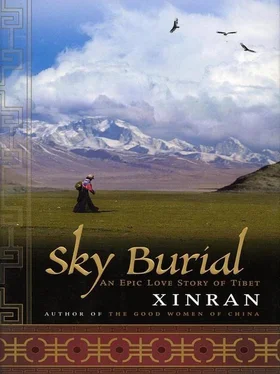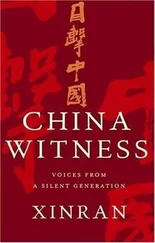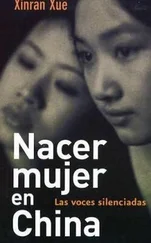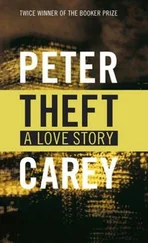Ni’s younger sister, Pad, was so quiet she hardly seemed to exist. Nevertheless, she was always close by to lend a helping hand, passing her mother or sister the very thing they were looking for. If, after the evening meal, Pad was seen pressing their belongings to the edge of the tent to keep out the draft, Saierbao would give everyone an extra blanket for the night and, sure enough, later Wen would hear the wind roaring outside the tent. Astonished by Pad’s predictive abilities, sometimes Wen was tempted to ask Zhuoma if Pad might have some knowledge of Kejun’s whereabouts. But she was too afraid of what she might learn from such a revelation. She didn’t dare risk a forecast that could crush her hopes.
The little boy Hum seemed to be about eight or nine. He loved being around other people, always wanting to learn everything. Wen often watched him with Om, who was teaching him to play the lute. Om would show his little brother the fingering and how to pluck the strings by tying the little boy’s fingers to his own as he played. Hum also liked to pull the butter-churning pole from his mother’s hands, leaving Saierbao no choice but to place a pile of dung sacks under his feet so he could see how to stir the pole through the milk. He would even run into a flock of sheep his father was trying to round up, copying how his father threw the lasso and yelled at the animals. Zhuoma told her that Hum was eager to enter a monastery like his two brothers. Wen couldn’t understand how a little boy who had never left home could be so keen to become a lama. She noticed that Hum prayed with a devoutness far beyond his years. Such maturity of belief in a boy not yet four feet tall must, Wen realized, be a true spiritual vocation.

EVERY DAY Wen noticed surprising things about the Tibetan way of life, and was constantly amazed by the differences between Tibetan and Chinese customs. One day, she discovered that Gela and Ge’er, not Saierbao, did all the family’s needlework. The first time she saw Ge’er sewing a robe, she could hardly believe it.
“Zhuoma,” she shouted, “come over here! What’s Ge’er doing?”
Saierbao, who was standing nearby, couldn’t understand Wen’s reaction. What was so surprising about the men in the family doing the sewing? Zhuoma told her that Chinese men hardly ever touched a needle, that sewing and mending were invariably women’s work. Ni fell about laughing after she heard this. “Women, sewing?” she said to her mother. “Surely not.”
Saierbao shook her head, sharing in her daughter’s disbelief at this absurd idea.
So, it was the men’s stubby fingers that were responsible for the whole family’s clothes and bedding, and even Om could sew a decent seam. Ge’er was particularly skilled with a needle and Wen learned that almost every item of ceremonial clothing the family possessed had been made by him.
Zhuoma explained that the clothes of the earliest people in Tibet had been made out of animal skins and furs, which needed to be sewn with very thick thread. Only the men had the strength to sew with needles like iron poles and ropelike thread. Although it was now possible for women to sew clothing, the old tradition remained.
WEN WAS eager to be able to repay the family’s hospitality by helping them with their work. However, she rapidly discovered that, although Saierbao swayed and hummed as she went about her tasks, they were by no means easy.
At first she found it impossible to milk the yaks. It was a job that demanded a great deal of skill. Worn out and dripping with sweat, Wen got nothing but complaints, and certainly no milk from the yaks. Even Pad, who quietly passed her a cloth to wipe away the sweat, couldn’t stop a little smile from crossing her face.
Making dung cakes looked easier but Wen soon found out that this was very deceptive. Before the dung could be dried, it had to be collected. She was supposed to scoop up the dung with a special curved shovel, and swing the droppings into a basket carried on her back. Then it had to be kneaded and patted into cakes, dried in the sun, neatly piled into sacks, and stored inside the tent. Wen usually ended up throwing the fresh dung all over herself instead of into the basket on her back. She howled at Zhuoma about how bad her aim was.
Being pure physical labor, fetching water required the least skill of all the chores. But it demanded great strength. Wen could hardly bear the weight of the water cask and would stagger along. More often than not, she would lose most of her load before she was halfway home.
Wen most wanted to master the butter churning. Saierbao said that her mother used to tell her that this was a woman’s most exhausting task-but also one of the skills for which she was most respected, because butter (and the yogurt and curds that were made from what was left over) was the essential ingredient of all three daily meals. Churning involved stirring milk in a wooden tub with a wooden pole hundreds of times, until the fat separated and could be ladled off to make the butter. Another process involved separating the curds and whey. The dried curds could be made into cakes with tsampa and were often used as religious offerings.
The equipment and methods used in churning reminded Wen of the chemistry experiments she used to do at the university. However, after half a morning helping Saierbao, she could hardly raise her arms, and by evening, her hands were too weak even to pick up her food and eat.
Wen recalled her mother telling her that an educated young Chinese woman should have a thorough grounding in six things: music, chess, calligraphy, painting, needlework, and cookery. A Tibetan woman was valued for a very different set of accomplishments. Wen blushed at the thought of her own incompetence. Even her medical training was of little use here. The family made their own herbal remedies, very different from those in Chinese medicine. Zhuoma showed her the mysterious caterpillar fungus and the saffron crocus, which were of great medicinal value. She understood now why Kejun had needed to undergo special training in how to use Tibetan herbs.
Zhuoma was also suffering with the work. Although she had a better understanding of what was expected, she was not used to physical labor and tired easily. Gela was kind to the two women and told them not to expect too much of themselves. The four seasons allowed people to move their homes, and yaks and sheep to mate and molt. They should take life a day at a time.

ONE DAY, Ni bounded up to tell her mother that Om said the grasses were budding. Saierbao screwed up her eyes and sniffed, as if to seize hold of the smell of summer. She told Zhuoma that Gela would shortly give the order to move to summer pastures on higher slopes. Again they would be traveling northward. Wen was in awe of the family’s understanding of the landscape. The concept of a map was utterly alien to them. They moved around by instinct, obeying the wisdom of ancient times: “In spring go to pasture by water, in summer on the mountains; in autumn go to pasture on the high slopes, in winter on the sheltered plains.” She realized that even if a map of this uncharted terrain had existed, she wouldn’t have been able to use it. She had absolutely no idea where she was and all the mountains and plains looked the same to her.
Everyone was excited at the thought of the summer move. The days had been growing warmer and longer, the sun was getting hotter and, at the midday meal, they would leave their fur jackets open. Wen, who was now comfortable on horseback, felt a new sense of self-confidence. She was sure that she was on the road to finding Kejun and imagined him bundled up in Tibetan clothing like her, struggling to survive and find his way home. She fantasized about a horseback reunion amid a flock of sheep and the pleasure of drinking milk tea with Kejun in a tent. She surprised Zhuoma with her happiness.
Читать дальше














